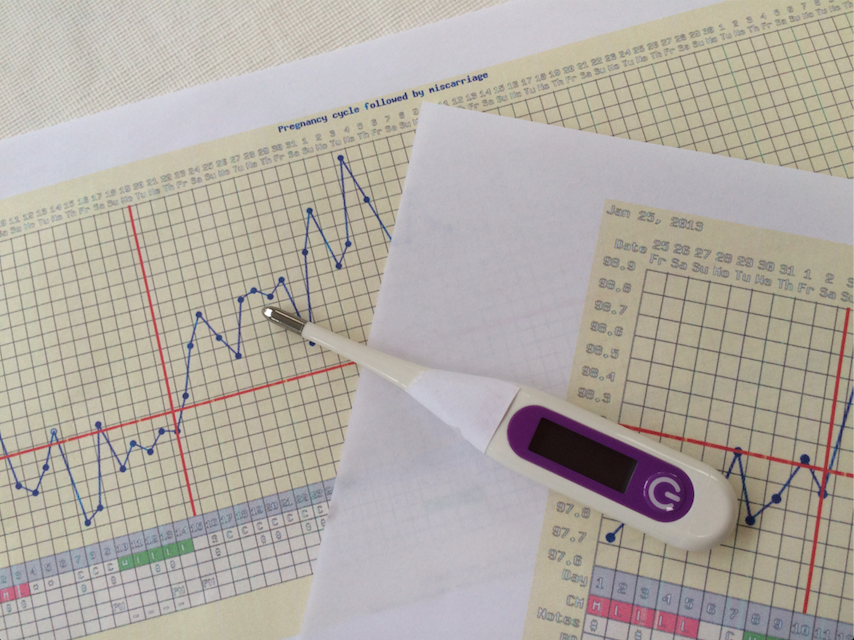What You Can Learn from Charting Your Menstrual Cycles

If you’ve been with me for a while, or have any familiarity with my story, you know that I started trying to conceive my first baby when I was 41 years old. After 13 months of trying and 2 losses, I finally conceived my son Charlie, who was 3 last December.
Most of the time, the reaction I get is amazement and disbelief. People can’t believe that I got pregnant and had my baby so quickly. My Diminished Ovarian Reserve diagnosis and my doctor’s prediction that my chances of having a baby with my own eggs was less than 2% adds to the amazement factor.
In the end, I did get pregnant with my own eggs, and without IVF.
The first question I almost always get is, “what did you do?”
I’ve written extensively about what I did during my journey to help me conceive. You can read the details here.
In my blog, I’ve gone into greater depth about my food choices. How I moved my body through sensible exercise. How I started sleeping better. How I set my intention to become a mother.
One thing I haven’t talked much about is one of the most important things I did. I started charting my cycles.
When I started trying to conceive, all I knew about my cycles was how long they were.
I was 41 years old and that was all I knew.
I started reading Toni Weschler’s Taking Charge of Your Fertility – aka, the Bible of female fertility – and my whole world changed.
I couldn’t believe how much I didn’t know about my cycles, my fertility, my body – especially at my age.
The book was incredibly illuminating and for this reason I recommend it as required reading for anybody on the fertility path – whether you’re in treatment or not, whether you’re embracing holistic methods or not, whether you’re just getting started trying to have a baby or have been trying for years.
The book advocates the fertility awareness method of conception planning – or, charting your daily basal body temperatures and other key fertility signs to track your menstrual cycles.
Basically, starting with Day 1 of your cycle, you take your temperature upon waking every day using a special thermometer called a basal thermometer. You can buy a basal thermometer at any pharmacy. Take your temperature at the same time every day, as soon as you wake up, before doing anything else including getting out of bed. It takes less than a minute to do. Record your temperature manually on a paper chart or using any of the popular apps available for smart phones.
It’s important to do it at the same time every day because basically, you’re collecting data, and the data points all need to be consistent to give you relevant and accurate information and analysis.
Your basal temperatures will confirm your ovulation. In the earlier phase of your cycle, the follicular phase, your temperatures will lower, as this phase of your cycle is dominated by estrogen, which is characterized by a cooler body. After ovulation, your body is dominated by the hormone progesterone, which is characterized by heat; therefore, your basal temperatures will be higher. It’s a subtle shift, so your body won’t actually feel hotter, but your basal thermometer will detect it.
The day of the temperature shift is ovulation day, and the 5 or so days leading up to it are your fertile days, and the time to try for conception. For this reason, temperature charting only confirms that ovulation occurred, and doesn’t tell you when it’s going to happen. After a few months of charting, however, you’ll get a handle on your cycles and will be able to start to use your basal chart as a predictive tool.
I’ve maintained for years that what you learn about your cycles and your body through charting gives you immense power over your fertility journey. Here are a few things you can learn:
- You confirm that you’re indeed ovulating. Ovulation is key to conception; there’s no way you can get pregnant without ovulating, and issues with ovulation are the leading cause of female infertility. It’s possible to have bleeding akin to menstrual bleeding without actually ovulating, and your basal temperatures will tell the story.
- You learn what’s normal for you. You get a handle of your usual ovulation day; our ovulation day can change from month to month based on various factors, which is why simply counting days isn’t reliable. Through charting your temperatures you’ll always know where exactly in your cycle you are.
- You can detect if there is something abnormal about your cycle. This may not always be apparent from counting the days of your cycle, but will emerge if you’re charting. For example, you could have a perfectly average 28-day cycle, which appears fine on the surface, but if you’re not ovulating until Day 18, that means that the luteal phase, or time after ovulation, is only 10 days. This could be too short to allow for successful implantation of an embryo. You wouldn’t know this and be able to take corrective action unless you’re charting.
For just a minute a day, you can learn about your own body, take control over your fertility, and get the information you need to be your own best advocate in your care, if you’re pursuing fertility treatment.
What do you have to lose?
To your fertility,
Stephanie xo



